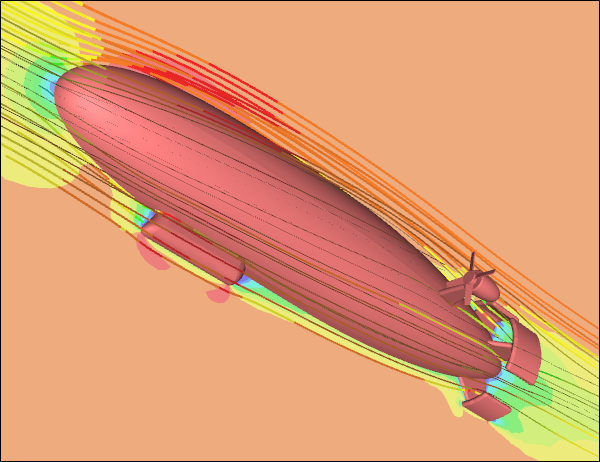
Airships Rising
Airships are enjoying a renaissance of sorts. Military forces have proposed airships for surveillance and heavy lift duties. A small number of impressive prototypes have already taken to the air, but little follow-on development seems imminent. Could this renaissance be just a bli(m)p?
 CFD Simulation of Flow Around an Airship
CFD Simulation of Flow Around an Airship
These new airship designs typically derive about 60% of their lift from buoyancy (helium being lighter than air), which makes them exceedingly efficient for surveillance and transport of relatively heavy loads. However, the Achilles heel of the airship is still its relatively low speed due to its massive drag compared to other forms of aircraft. For surveillance, air speed is not always a priority. For military equipment, deployment speed can be a critical mission success factor.
Long Endurance Multi-Intelligence Vehicle (LEMV)
Using airships to transport cargo in the civilian realm shows some promise, at least in concept. Currently cargo ships and planes are the primary means to transport goods between continents. Airships may offer a viable third option somewhere between ships and planes in terms of both speed and capacity. Unfortunately, the current return on investment for cargo airships appears to be too uncertain to justify much interest from the private sector.
It appears that the success or otherwise of the latest airship renaissance is in the hands of the military. Given the military's deep pockets they can take high-risk, high-reward (blue sky research) gambles that can reduce the level of risk to an acceptable level for the private sector airship industry to take off.
Notes
- The airship geometry was sourced from FiSiBLE STaTE.
- The airship symmetrical half model geometry was prepared in Caedium Professional. The CFD simulation was performed using the incompressible, steady-state RANS solver, with a Moving Reference Frame (MRF) around the propeller, and the k-omega SST turbulence model.
Recent blog posts
- CFD Simulates Distant Past
- Background on the Caedium v6.0 Release
- Long-Necked Dinosaurs Succumb To CFD
- CFD Provides Insight Into Mystery Fossils
- Wind Turbine Design According to Insects
- Runners Discover Drafting
- Wind Tunnel and CFD Reveal Best Cycling Tuck
- Active Aerodynamics on the Lamborghini Huracán Performante
- Fluidic Logic
- Stonehenge Vortex Revealed as April Fools' Day Distortion Field
